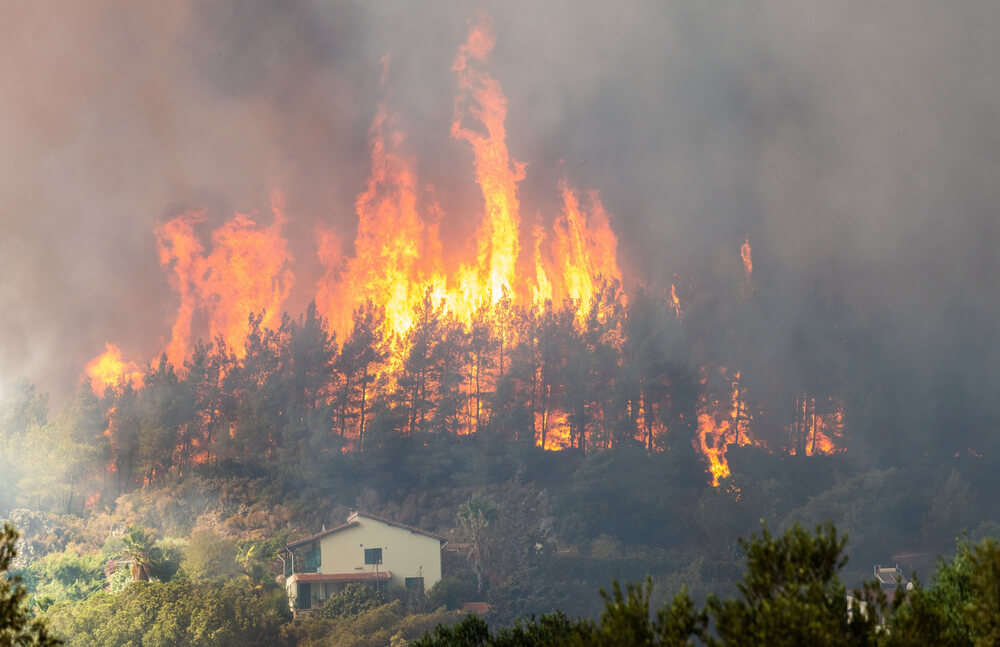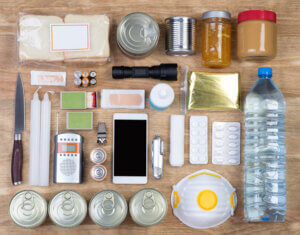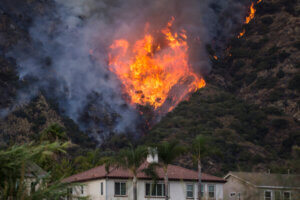Most wildfires begin unnoticed and quickly spread, igniting everything in their path. The mention of wildfire near your home can cause panic and fear. The best way to handle a wildfire is to make sure both your home and family are well prepared. If you’re concerned about wildfires in your area, here’s what to do before, during and after to prepare your home a wildfire.
How To Prepare for Wildfires
If there is a wildfire warning in effect in your area, it’s important you take the proper steps to protect your home as much as possible. Follow these steps to best prepare yourself for the worst.
1. Prepare an Emergency Kit
Take the time now to prepare an emergency kit if you do not already have one. Some key items to include are:
- Water — the recommended amount is two litres of water per person per day. Stock up on bottles of water and make sure there is enough for each member in your family.
- Food — canned goods, energy or protein bars, and dried foods are good options. They should be replaced in your kit once a year.
- Manual can opener — your canned goods will be of no use if you cannot open them.
- Wind-up or battery-powered flashlight — remember to add extra batteries.
- Wind-up or battery-powered radio — again be sure to add extra batteries.
- First aid kit — include backup medications, pills, or anything else you might need for first aid.
- Extra set of keys — add a set of extra house and car keys.
- Cash — if bank machines are down the only way to get money is to already have some cash set aside.
- Important family documents — items such as identification, bank and insurance records should be kept safe and taken with you.
- Extra clothes — who knows what the weather conditions will be like and if you’ll be able to gather clothes before evacuating.
You can always add more items to your kit, but these items should all be included to start. Be sure to store your emergency kit in a safe but easily accessible place. Places like the garage or a coat closet are good options.
2. Remove Fire Hazards from Around Your Home
Experts recommend that you create a 30 to 100-foot safety zone around your home. This safety zone will be where you can implement the following tips to reduce potential exposure to flames and heat from wildfires.
A key step to preparing your home for a wildfire is to make sure all potential fire hazards have been removed. Start by removing any dried branches, leaves, shrubs or debris from around the outside of your home. If you have trees that overhang onto your home, have them trimmed by a tree service company. Be sure to rake leaves and do not let them pile up. The less dried material the fire has to catch on to, the better.
The types of trees you plant around your home can either fuel or contain wildfires. For example, hardwood trees are less flammable than pine, evergreen, eucalyptus or fir trees. If you live in an area prone to wildfires, be sure to take this into consideration when planning your landscape.
Make sure that your roof and gutters are regularly cleaned. Old, dry leaves are the perfect kindling for a wildfire. Hire a gutter cleaning service to come by regularly to take care of this for you. Another item to keep clean that will help with wildfires is your chimney. It should be inspected at least twice a year, and cleaned at least once a year. You can hire a chimney sweep by clicking here.
3. Create an Escape Plan
It’s important you and every member of your household know what to do in the event of an emergency. Sit down and create an escape plan and make sure everyone knows what to do and where to go. You should include ways for family members to get in contact in case they are separated during an evacuation.
What To Do When a Wildfire Approaches
The first thing to do is to report the fire to 9-1-1 or your local emergency number. If conditions appear to be safe and there is time before the fire arrives, take the following steps:
- Close all windows and doors.
- Cover all other openings, such as vents, with duct tape.
- Turn off any natural gas or propane tanks. Propane tanks or barbeques should be moved into the open, away from structures.
- Move any combustibles away from your home; this includes firewood and lawn furniture.
- Gather your emergency kit and prepare to execute your escape plan.
- Evacuate your family and pets to a safe location and wait for further updates.
What To Do During a Wildfire
If you have been advised to evacuate due to a wildfire, do so immediately. Gather your emergency kit and follow your escape plan. If you have the time, disconnect any automatic garage door openers so that doors can still be opened by hand if the power is disconnected.
If you have not been told to evacuate, the best thing you can do during a wildfire is to stay safe. Monitor local radio stations for instructions and updates. Be prepared to evacuate at any time and be aware of safe areas you can go to.
If you do not yet need to evacuate but the fires are burning, be sure to keep safe while inside your home. Keep all doors and windows shut and remove any flammable curtains or drapes from around windows. Keep your lights on as this will aid in the visibility of smoke in your home.
Dealing with Poor Air Quality
Wildfires create vast amounts of smoke that are full of gases and fine particles caused by burning wood and plant matter. This combination in the smoke creates a toxic mixture that when inhaled can lead to developing asthma, respiratory and heart problems. There are steps you can take to ensure you are not exposed to too much smoke in the air.
While the air outside may be dangerous, it’s important to keep the air inside your home as clean as possible if you are advised to say inside. While your windows and doors will need to remain shut, you are able to run your air conditioner. When running your air conditioner during a wildfire make sure that you keep the fresh air intake closed and keep the filter clean. If you’re concerned about the cleanliness of your air conditioner and filter, click here to connect with an HVAC specialist who will be able to clean it properly for you and ensure you are not breathing in harmful smoke during a wildfire.
Another thing to keep in mind is the quality of your doors and windows. If you have old windows that leak, it’s likely that smoke will be able to find its way in even if your windows are closed. Whether you need to get your windows replaced or just have the weatherstripping updated, you can quickly and easily do so by clicking here to find a windows specialist in your area.
What To Do After a Wildfire
You will need to check for updates whether it is safe to return to your home or not. Listen to the radio and look online for updates. These updates will also let you know safe and unsafe areas and whether water is safe to drink.
After a wildfire, phone lines are often tied up and busy if they are working at all. Use social media or text messages to reach out to friends and family to find out if they’re safe and to let them know how you’re doing.
Wildfires dramatically affect the landscape around you. Be sure to avoid hot ash, smoldering debris and live embers. The ground may contain heat pockets that can be hot enough to burn you or even start another fire. Heavy rains and flash flooding are another concern after a wildfire. If you are concerned about the likelihood of flooding, consider purchasing flood insurance, or speak to a waterproofing expert to assess your home.
No one wants to have their life disrupted by a wildfire, but being prepared and knowing what to do in the event of one is the best way to maintain your safety. Take the time to prepare when possible and ensure every member of your household knows what to do in the event of a wildfire. Remember that safety comes first and prevention is your best defence against wildfires.


